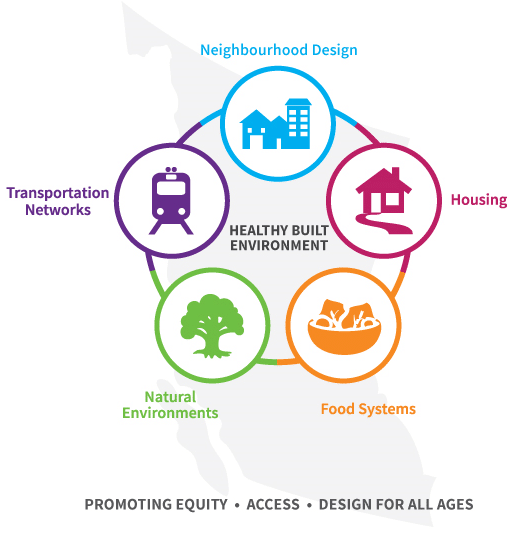Think about how likely you would be to ride your bike to the park instead of driving, choose healthier foods, or stop to chat with neighbours if you didn’t feel safe or if the services you need are not accessible or affordable. Community design has significant influence on behaviour, and partnering with local governments in our public health efforts is a powerful strategy to encourage healthy living and prevent chronic disease.
To support the integration of health considerations within community planning and design, BCCDC Population & Public Health has released an update to the Healthy Built Environment Linkages Toolkit. Since its original release in 2014, the Toolkit has been rapidly adopted by health professionals and others who collaborate with local governments for credible health research and key messages.
Based on literature reviews and weighted assessment criteria, the Toolkit considers five core “features” of the built environment: neighbourhood design, transportation systems, food systems, natural environments and housing. The updated version includes refreshed research and new considerations of practice including working with small- and medium-sized communities, findings on economic co-benefits of healthier built environments, and social well-being outcomes.
“Community design can reduce environmental health risks associated with chronic diseases and conditions like cancer, cardiovascular conditions, mental illness, as well as preventable injuries.”
Each of the five core features include a synthesis of key findings and research relationships between planning principles and health outcomes. Healthier weights, for example, are associated with the walkability of our neighbourhoods and transportation systems. Similarly, community design which maximizes access to natural environments are shown to increase physical activity and social well-being, and decrease stress.
Intentional community design can even help shift broader social determinants of health when planning principles acknowledge and address inequities. For example, the inclusion of different types of housing in a community is shown to positively influence residential instability and financial stress. Equitable access to affordable healthy food options is strongly associated with improved diet quality and food service options.
Interestingly, positive health outcomes can often be triggered through more than one aspect of the built environment. Improved mental health and social well-being, for example, can be supported across all aspects of the built environment via potential planning interventions described in the Toolkit. This allows health professionals the flexibility to weigh planning options and consider multiple health priorities and diverse contexts when in consultation with local governments on local area planning processes.
The Toolkit is supported by the BC Healthy Built Environment Alliance (HBEA) Steering Committee, and is maintained in close collaboration with partner organizations and content experts from regional health authorities, universities, local government and non-profit organizations. In the next few months, we will be hosting webinars to present what’s new in the updated toolkit including refreshed content and research area findings. Webinar dates will be circulated once confirmed. We are also developing an online tool to help bring the health evidence described in the Toolkit to life. This tool will allow users to interact with the research pathways and more easily access source literature. We anticipate completion by December 2018.
The full report and two-page summary can be found on the BC Centre for Disease Control (BCCDC) website.
Please feel free to contact Charito Gailling, Project Manager, BCCDC for any feedback, questions or comments.




